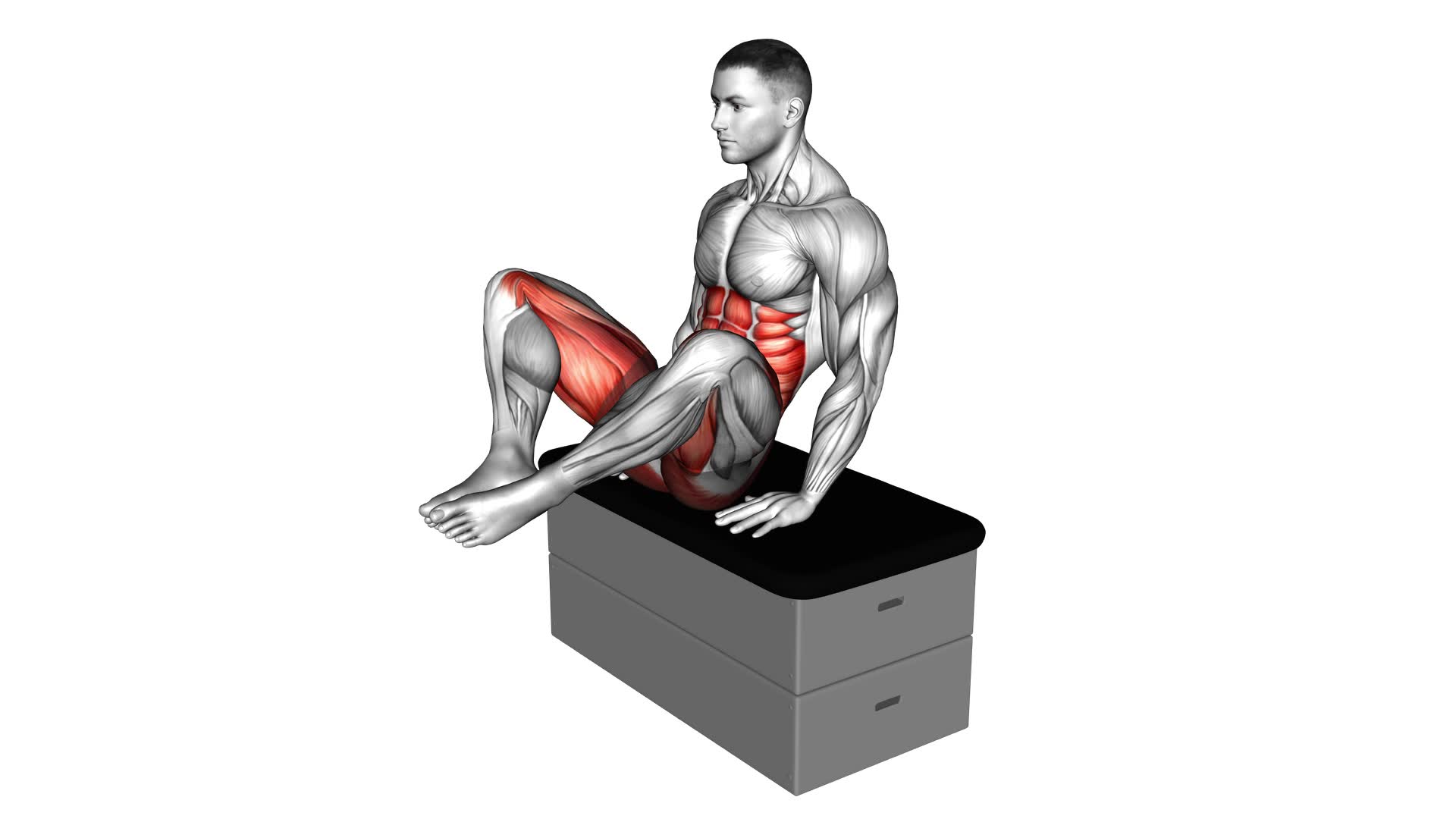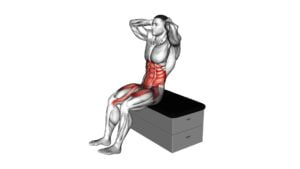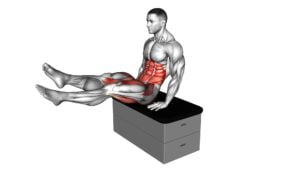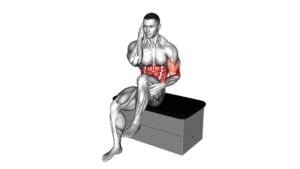Sitting Frog Crunch on a Padded Stool – Video Exercise Guide & Tips

Get ready to strengthen your core with the Sitting Frog Crunch on a Padded Stool! This exercise is a great way to target your abs and improve your stability.
Watch This Exercise Video
In this video exercise guide, we'll show you how to set up the padded stool, demonstrate the proper form and technique, and provide variations to challenge yourself.
Plus, we'll share common mistakes to avoid and offer tips for progression and safety.
Let's dive in and start crunching!
Key Takeaways
- Sitting frog crunch on a padded stool targets abs and improves stability.
- Proper form and technique, such as engaging core muscles and using controlled movements, should be maintained to avoid common mistakes and reduce strain on the lower back.
- Gradually increasing the range of motion, repetitions, and incorporating resistance can help progress the exercise and improve strength.
- It is important to listen to your body, warm up before performing the exercise, and seek professional advice for any medical conditions or injuries.
Benefits of the Sitting Frog Crunch
You can experience a range of benefits from practicing the Sitting Frog Crunch on a padded stool. This exercise is a modified version of the traditional frog crunch, specifically designed for those who prefer or require a seated position during their ab workout.
One of the advantages of seated ab exercises, like the Sitting Frog Crunch, is that they can provide better support for your lower back, reducing the risk of strain or injury. By using a padded stool, you can further enhance this support and ensure a comfortable experience.
In addition to the reduced strain on your back, the Sitting Frog Crunch also targets your abdominal muscles effectively. This exercise engages the rectus abdominis, obliques, and transverse abdominis, helping to strengthen and tone your core. It also improves your overall posture and stability, as you engage your core muscles to maintain balance on the stool.
Setting up the Padded Stool
To set up the padded stool for your seated ab workout, position it on a flat and stable surface. Make sure there's enough space around the stool for you to move comfortably without any obstructions. This will ensure that you have a safe and effective workout.
When setting up the padded stool, finding the right height is crucial. You want to make sure that your feet can comfortably rest on the ground while you sit on the stool. This will provide stability and support for your body during the exercise. If the stool is too high, it can strain your lower back and make it difficult to maintain proper form. On the other hand, if the stool is too low, it can put unnecessary pressure on your knees and make the exercise uncomfortable.
To find the right height, stand next to the stool and adjust it so that the seat is level with your hip bone. This will ensure that your feet can rest comfortably on the ground while you sit. Once you have set the height, double-check to make sure that the stool is stable and doesn't wobble. Adjust as needed until you're confident in its stability.
Proper Form and Technique
When setting up the padded stool, it's crucial to maintain proper form and technique for a safe and effective seated ab workout. To ensure you get the most out of your exercise, it's important to dispel common misconceptions and understand modifications for beginners.
One common misconception is that you need to forcefully pull your knees towards your chest during the frog crunch. However, this can strain your lower back and neck. Instead, focus on engaging your core muscles and using controlled movements. Slowly bring your knees towards your chest, feeling the contraction in your abs, and then slowly return to the starting position. This will help prevent injuries and maximize the effectiveness of the exercise.
For beginners, it's recommended to start with modifications until you build enough strength and stability. You can place your hands on the sides of the padded stool for support, providing an anchor to assist with the movement. Additionally, you can reduce the range of motion by not bringing your knees all the way to your chest. Gradually increase the intensity as you become more comfortable and confident in your abilities.
Variations to Challenge Yourself
To further challenge yourself, occasionally incorporate advanced variations into your seated ab workout routine. These advanced modifications will help you push your limits and continue to progress in your fitness journey.
Here are three variations that you can try:
- Weighted Frog Crunch: Hold a dumbbell or a weighted plate against your chest while performing the frog crunch. The added resistance will engage your abdominal muscles even more and increase the intensity of the exercise.
- Oblique Twists: Instead of bringing your knees towards your chest in a straight line, twist your torso to the left or right as you crunch. This variation targets your oblique muscles, adding an extra challenge to your workout.
- Leg Extensions: After performing the frog crunch, extend your legs straight out in front of you, hovering them just above the ground. Hold this position for a few seconds before returning to the starting position. This modification increases the difficulty by engaging your lower abs and challenging your core stability.
Incorporating these advanced variations and incorporating weights into your seated ab workout routine will help you take your training to the next level. Remember to listen to your body and only progress to these variations when you feel ready.
Common Mistakes to Avoid
One common mistake to avoid during the seated ab workout routine is improper form. It's essential to maintain proper alignment throughout the exercise to effectively target your abdominal muscles and prevent injuries.
One common mistake is rounding your back or slouching while performing the sitting frog crunch. This improper form not only reduces the effectiveness of the exercise but also puts strain on your lower back. To avoid this, focus on keeping your spine straight and your core engaged throughout the movement.
Another mistake to avoid is using momentum to lift your legs instead of relying on your abs. This cheat reduces the work on your abdominal muscles and shifts the tension to other muscle groups. To overcome this, concentrate on using your abs to lift your legs and control the movement.
Additionally, avoid pulling on your neck or using your hands to push yourself up. This can strain your neck and take away from the effectiveness of the exercise. Instead, place your hands lightly on the sides of the stool or keep them relaxed in your lap.
Tips for Progression and Safety
To safely progress in your seated frog crunch routine and maximize the benefits, focus on maintaining proper form and gradually increasing the difficulty of the exercise. Here are some tips for progression and safety:
- Progression Modifications:
- Start with a shorter range of motion and gradually increase it as you become more comfortable and confident.
- Increase the number of repetitions or sets as you get stronger and more experienced.
- Incorporate resistance by holding a medicine ball or weight plate against your chest while performing the crunch.
- Injury Prevention Techniques:
- Engage your core muscles and maintain a stable spine throughout the exercise to prevent strain on your lower back.
- Avoid jerky or rapid movements that can put unnecessary stress on your neck and shoulders.
- Listen to your body and take breaks if you feel any pain or discomfort during the exercise.
- Safety Precautions:
- Make sure the padded stool you're using is stable and can support your weight.
- Always warm up before performing the seated frog crunch to prepare your muscles for the exercise.
- If you have any pre-existing medical conditions or injuries, consult with a healthcare professional before attempting this exercise.
Frequently Asked Questions
How Long Should I Perform the Sitting Frog Crunch Exercise For?
To effectively perform the sitting frog crunch exercise, you should focus on maintaining proper form and engaging your core muscles.
As for how long you can do this exercise, it depends on your fitness level and comfort. It's important to listen to your body and start with a duration that feels challenging but manageable.
Gradually increase the time as you build strength and endurance. Always prioritize safety and consult with a fitness professional if needed.
Can I Do the Sitting Frog Crunch Exercise on a Regular Chair Instead of a Padded Stool?
Yes, you can do the sitting frog crunch exercise on a regular chair instead of a padded stool. However, using a padded stool has its benefits.
It provides extra cushioning and support for your back, making the exercise more comfortable and minimizing the risk of strain or injury. The padding also helps to maintain proper form and alignment during the movement.
Are There Any Modifications for Individuals With Lower Back Pain?
If you're dealing with lower back pain, there are modifications you can make to the sitting frog crunch exercise. It's important to prioritize your comfort and safety.
You could try doing the exercise on a padded surface or using a folded towel for extra support. Another option is to perform a modified version of the exercise, such as a seated knee-to-chest stretch, which can still help strengthen your core.
Can I Incorporate Weights or Resistance Bands Into the Sitting Frog Crunch Exercise?
Sure, you can definitely incorporate weights or resistance bands into the sitting frog crunch exercise. Adding weights or resistance bands will increase the intensity of the exercise and help target your muscles even more. It's a great way to challenge yourself and take your workout to the next level.
However, it's important to start with lighter weights or resistance bands and gradually increase as you get stronger. Always listen to your body and make sure to use proper form to avoid injury.
How Often Should I Include the Sitting Frog Crunch Exercise in My Workout Routine?
To determine the frequency and duration of the sitting frog crunch exercise in your workout routine, it's important to consider your fitness goals and overall fitness level.
This exercise can be effective for targeting your core muscles, so incorporating it 2-3 times a week for about 10-15 minutes each session can be beneficial.
However, it's always recommended to consult with a fitness professional to tailor your workout routine to your specific needs and goals.
Conclusion
In conclusion, the sitting frog crunch on a padded stool is a challenging exercise that targets the core muscles. By following proper form and technique, you can maximize the benefits of this exercise.
Additionally, incorporating variations can help increase the intensity and challenge yourself. It's important to avoid common mistakes and prioritize safety during your workout.
With consistent practice and progression, you can effectively strengthen your core and improve your overall fitness.

Author
Years ago, the spark of my life’s passion ignited in my mind the moment I stepped into the local gym for the first time. The inaugural bead of perspiration, the initial endeavor, the very first surge of endorphins, and a sense of pride that washed over me post-workout marked the beginning of my deep-seated interest in strength sports, fitness, and sports nutrition. This very curiosity blossomed rapidly into a profound fascination, propelling me to earn a Master’s degree in Physical Education from the Academy of Physical Education in Krakow, followed by a Sports Manager diploma from the Jagiellonian University. My journey of growth led me to gain more specialized qualifications, such as being a certified personal trainer with a focus on sports dietetics, a lifeguard, and an instructor for wellness and corrective gymnastics. Theoretical knowledge paired seamlessly with practical experience, reinforcing my belief that the transformation of individuals under my guidance was also a reflection of my personal growth. This belief holds true even today. Each day, I strive to push the boundaries and explore new realms. These realms gently elevate me to greater heights. The unique combination of passion for my field and the continuous quest for growth fuels my drive to break new ground.



